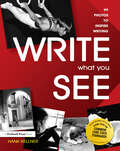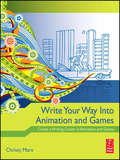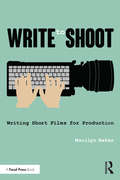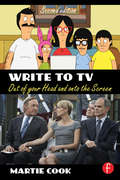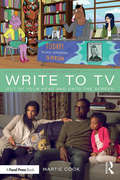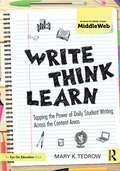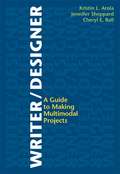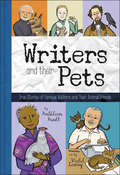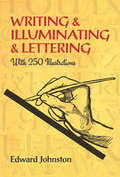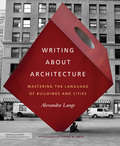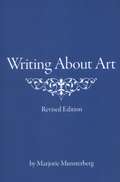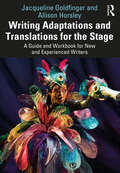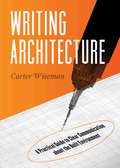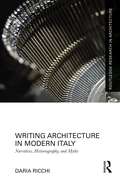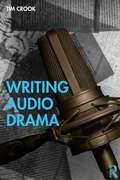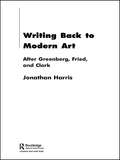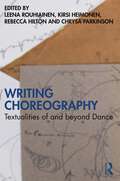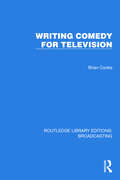- Table View
- List View
Write A Play - And Get It Performed: Teach Yourself
by Lesley Bown Ann GawthorpeWrite a Play - and Get It Performed is designed for would-be writers of every level and for all types of motivation by two prize-winning professionals. Whether writing for the specific needs of an amateur drama group, community event, political campaign or simply for personal or professional development, this is a guide to the craft of playwriting. It offers guidance on the creative principles of scripts, characters, plot, structure and dialogue and explains the principles of staging and stage directions as well as gives tips on how to write for a variety of different situations, for every age and ability and according to specific genres - particularly those often preferred by amateur groups, such as pantomime and musical theatre. NOT GOT MUCH TIME? One, five and ten-minute introductions to key principles to get you started. AUTHOR INSIGHTS Lots of instant help with common problems and quick tips for success, based on the author's many years of experience. TEST YOURSELF Tests in the book and online to keep track of your progress. EXTEND YOUR KNOWLEDGE Extra online articles at www.teachyourself.com to give you a richer understanding of writing a play. FIVE THINGS TO REMEMBER Quick refreshers to help you remember the key facts. TRY THIS Innovative exercises illustrate what you've learnt and how to use it.
Write A Play And Get It Performed: Teach Yourself
by Lesley Bown Ann Gawthorpe Lesley HudswellWrite a Play - and Get It Performed is designed for would-be writers of every level and for all types of motivation by two prize-winning professionals. Whether writing for the specific needs of an amateur drama group, community event, political campaign or simply for personal or professional development, this is a guide to the craft of playwriting. It offers guidance on the creative principles of scripts, characters, plot, structure and dialogue and explains the principles of staging and stage directions as well as gives tips on how to write for a variety of different situations, for every age and ability and according to specific genres - particularly those often preferred by amateur groups, such as pantomime and musical theatre.NOT GOT MUCH TIME?One, five and ten-minute introductions to key principles to get you started.AUTHOR INSIGHTSLots of instant help with common problems and quick tips for success, based on the author's many years of experience.TEST YOURSELFTests in the book and online to keep track of your progress.EXTEND YOUR KNOWLEDGEExtra online articles at www.teachyourself.com to give you a richer understanding of writing a play.FIVE THINGS TO REMEMBERQuick refreshers to help you remember the key facts.TRY THISInnovative exercises illustrate what you've learnt and how to use it.
Write What You See: 99 Photos to Inspire Writing (Grades 7-12)
by Hank KellnerMotivate your students with the wide variety of photographs and writing prompts in this delightful book by award-winning photographer and former English teacher Hank Kellner.The varied prompts include key words, questions to consider, ideas for writing, possible opening lines, suggestions for research, and more. The book even comes with a CD so that you have the option of displaying the activities with an overhead projector.Write What You See contains a wealth of ideas for writing from the author as well as from real teachers across the country who have successfully used photography in the teaching of writing.Grades 7-12
Write Your Way into Animation and Games: Create a Writing Career in Animation and Games
by Christy MarxLaunch your career in writing for video games or animation with the best tips, tricks, and tutorials from the Focal press catalog--all at your fingertips. Let our award-winning writers and game developers show you how to generate ideas and create compelling storylines, concepts, and narratives for your next project. Write Your Way Into Animation and Games provides invaluable information on getting into the game and animation industries. You will benefit from decades of insider experience about the fields of animation and games, with an emphasis on what you really need to know to start working as a writer. Navigate the business aspects, gain unique skills, and develop the craft of writing specifically for aniamtion and games. Learn from the cream of the crop who have shared their knowledge and experience in these key Focal Press guides: Digital Storytelling, Second Edition by Carolyn Handler Miller Animation Writing and Development by Jean Ann Wright Writing for Animation, Comics, and Games by Christy Marx Story and Simulations for Serious Games by Nick Iuppa and Terry Borst Writing for Multimedia and the Web, Third Edition by Timothy Garrand
Write to Shoot: Writing Short Films for Production
by Marilyn BekerWrite to Shoot teaches budding screenwriters and screenwriting filmmakers how to write a short script with production in mind. Beker instructs them how to showcase their strengths, tailor projects to shoestring budgets, resources, and practical production parameters without sacrificing the quality and punch of their screenplays, whether they're creating a sizzle short for an unproduced feature script, an independent creative work, or a soapbox to promote a cause. Write to Shoot: Writing Short Films for Production is a must-have guide for anyone who wants to be sure there will be no surprises on set that come from a script that's not ready for production.
Write to TV: Out of Your Head and onto the Screen
by Martie CookLearn to craft smart, original stories and scripts for a variety of television formats and genres, including comedy, drama, pilots, animation, made-for-TV movies, late night, and reality television. Hear directly from studio and network executives, agents, and managers on what they're looking for in new writers and how to avoid common pitfalls. Gain access to sample outlines, script pages, checklists, and countless other invaluable resources that will help you break into the industry and put you on the path to immediate success. In Write to TV, Second Edition industry veteran Martie Cook offers practical advice on writing innovative television scripts that will allow you to finally get that big idea out of your head and onto the screen. This new edition has been updated to include: Tips and techniques from industry vets Jay Leno, Norman Lear, Paul Haggis, David Magee, Susan Rovner, Tal Rabinowitz, Jonathan Littman, Peter Jankowski, Steve Stark, and Doug Herzog that you can immediately apply to your own projects Expanded coverage of writing pilots, pitching, writing webisodes, writing for tweens, writing for late night, and rewriting Useful advice for navigating the confusing television hierarchy, including how to network, get an agent, land that first writing job, and even "do lunch" 25 new interviews with writers and producers of hit shows such as New Girl, Parks and Recreation, The Blacklist, Curb Your Enthusiasm, CSI, The Tonight Show Starring Jimmy Fallon, and many more An all new companion website (www.writetotv.com) featuring blog updates, industry trends, a Q&A discussion forum with the author, and many other resources
Write to TV: Out of Your Head and onto the Screen
by Martie CookIn Write to TV (third edition) industry veteran Martie Cook offers practical advice on writing innovative television scripts that will allow you to finally get that big idea out of your head and onto the screen. With this book you’ll learn to craft smart, original stories and scripts for a variety of television formats and genres, including comedy, drama, pilots, web series, and subscription video on demand. This new edition has been updated with expanded coverage on writing for global audiences, content creation for streaming services such as Netflix, Amazon and Hulu, as well as writing the web series, podcasts and utilizing free platforms such as YouTube. It also features new chapters on writing for niche markets; breaking into the writers’ room; creating binge-worthy series and how to accompany pilot scripts with a series pitch document. Plus, expanded information on creating complex and compelling characters including writing anti-heroes and strong female protagonists and much, much more. Including information directly from studio and network executives, agents, and managers on what they’re looking for in new writers and how to avoid common pitfalls, advice from successful creators and showrunners on creating original content that sells, and tips from new writers on how to get into a writers room and stay there. This book contains information from more than 20 new interviews, access to sample outlines, script pages, checklists, and countless other invaluable resources, and is the ideal book for anyone who wants to break into the TV writing industry.
Write, Think, Learn: Tapping the Power of Daily Student Writing Across the Content Areas
by Mary K. TedrowFind out how to create the climate and space for everyday student writing. In this new co-publication with MiddleWeb, award-winning teacher Mary Tedrow shows you how to encourage students to integrate daily writing into their lives, leading to improved critical thinking skills, increased knowledge of subject areas, and greater confidence in written expression. This practical guide will help you consider the unique needs of your students, while still meeting state standards. You’ll discover how to… Develop classroom routines and activities that invite creativity and self-expression Teach writing methods that can be used across different grade levels and all content areas Challenge students to examine their own writing processes for thinking and problem solving Evaluate written work in a way that emphasizes growth over grades Many exercises, prompts, and attempts at thinking found in the book can be easily adapted for use both in and out of the classroom. Whether you are a new or experienced teacher, Write, Think, Learn will enable you to make writing come alive for all your students.
Writer Designer: A Guide to Making Multimodal Projects
by Cheryl E. Ball Kristin L. Arola Jennifer SheppardCreating multimodal projects can seem daunting, but Writer/Designer streamlines the multimodal composing process and makes it manageable for students. Designed to work in any college course, this brief, accessible book is here to help students whether they are creating a poster, a webtext, an animated video, or any other kind of text. Write/Design assignments guide students through the process of researching the right genre for their project, finding the tools to work with different media, drafting with mockups and storyboards, and presenting their final projects to the world.
Writer/Designer: A Guide to Making Multimodal Projects
by Cheryl E. Ball Kristin L. Arola Jennifer SheppardCreating multimodal projects can seem daunting, but Writer/Designer streamlines the multimodal composing process and makes it manageable for students. Designed to work in any college course, this brief, accessible book is here to help students whether they are creating a poster, a webtext, an animated video, or any other kind of text. Write/Design assignments guide students through the process of researching the right genre for their project, finding the tools to work with different media, drafting with mockups and storyboards, and presenting their final projects to the world. Online examples, tutorials, and activities in e-Pages take advantage of what the Web can do, showcasing real multimodal compositions from both students and professionals.
Writers and Their Pets: True Stories of Famous Authors and Their Animal Friends
by Kathleen KrullDiscover how animals influenced 20 of the world’s most beloved authors, from Charles Dickens to J.K. Rowling. Did you know that a dog saved Pablo Neruda’s life? Or that Mark Twain had a cat named Bambino? Or that Edgar Allen Poe wrote with a cat on his shoulders? Writers and Their Pets tells these stories and many more with playful full-color illustrations that will delight not only children, but also literary experts, history lovers, and animal enthusiasts. Each short chapter focuses on one author’s life, using simple and entertaining text to weave tales of the pets that affected the lives and works of these writers, with illustrative artwork sprinkled throughout each page. This title features a diverse list of both male and female international authors, spanning from the 19th to the 21st century, including Beatrix Potter, E.B. White, Elizabeth Barrett Browning, Kurt Vonnegut, Maurice Sendak, Ernest Hemingway, and and more.
Writing & Illuminating & Lettering: With 250 Illustrations
by Edward JohnstonOne of the founders of modern calligraphy, Edward Johnston regarded lettering, writing, and illuminating as not only desirable ends in themselves but also as practical avenues to mastery of typography, decoration, and design. In this classic, profusely illustrated guide, he distilled his expertise into a series of easy-to-follow lessons that will benefit any student of calligraphy, book design, or art.Part I is devoted to writing and illuminating. Early chapters cover the fundamentals of acquiring a formal hand: choosing paper, ink, and quills; holding the pen; spacing and planning a manuscript; and more. The author then turns to the techniques of producing a manuscript book: tools and materials, methods and proportions, margins, and other methods. Part II offers a detailed discussion of lettering: the qualities of good lettering, methods of construction and arrangement, spacing, proportion, and other matters. Two appendixes cover the uses of lettering in book bindings, wall inscriptions, monograms, and title pages as well as the techniques involved in lettering on metal, wood, and stone.
Writing About Architecture: Mastering the Language of Buildings and Cities
by Alexandra Lange Jeremy M. LangeExtraordinary architecture addresses so much more than mere practical considerations. It inspires and provokes while creating a seamless experience of the physical world for its users. It is the rare writer that can frame the discussion of a building in a way that allows the reader to see it with new eyes. Writing About Architecture is a handbook on writing effectively and critically about buildings and cities. Each chapter opens with a reprint of a significant essay written by a renowned architecture critic, followed by a close reading and discussion of the writer's strategies. Lange offers her own analysis using contemporary examples as well as a checklist of questions at the end of each chapter to help guide the writer. This important addition to the Architecture Briefs series is based on the author's design writing courses at New York University and the School of Visual Arts. Lange also writes a popular online column for Design Observer and has written for Dwell, Metropolis, New York magazine, and The New York Times. Writing About Architecture includes analysis of critical writings by Ada Louise Huxtable, Lewis Mumford, Herbert Muschamp, Michael Sorkin, Charles Moore, Frederick Law Olmsted, and Jane Jacobs. Architects covered include Marcel Breuer, Diller Scofidio + Renfro, Field Operations, Norman Foster, Frank Gehry, Frederick Law Olmsted, SOM, Louis Sullivan, and Frank Lloyd Wright.
Writing About Art (Revised Edition)
by Marjorie MunsterbergWriting About Art was written as the text for a course of the same name required of all art majors at The City College of New York. The book explains the different approaches college students encounter in undergraduate art history classes. Each chapter outlines the characteristics of one type of visual or historical analysis and briefly explains its history and development. Passages by well-known art historians provide examples of each method. Sample essays by students are accompanied by extensive explanations of suggested revisions. The book also includes a step-by-step guide to researching art historical topics and a section about correctly citing sources.
Writing Adaptations and Translations for the Stage: A Guide and Workbook for New and Experienced Writers
by Jacqueline Goldfinger Allison HorsleyWriting Adaptations and Translations for the Stage is a practical guide for writing adapted works for theatrical performance. Broadway translator and dramaturg Allison Horsley and award-winning playwright and educator Jacqueline Goldfinger take readers step-by-step through the brainstorming, writing, revision, and performance processes for translations and adaptations. The book includes lectures, case studies, writing exercises, and advice from top theater professionals on the process of creating, pitching, and producing adaptations and translations, covering a wide range of topics such as jukebox musicals, Shakespeare adaptations, plays from novels, theater for young adults, and theater in translation and using Indigenous language. Artists who share their wisdom in this book include: Des McAnuff (Tony Award), Emily Mann (Tony Award), Dominique Morisseau (Broadway Adaptor, Tony Award nominee, MacArthur Genius Fellow), Lisa Peterson (Obie Award, Lortel Award), Sarah Ruhl (Broadway Playwright, Tony Award nominee, Pulitzer Prize finalist, MacArthur Genius Fellow), and Tina Satter (Broadway Director, Obie Award, Guggenheim Fellowship). The book also features interviews with artists working both in the US and internationally, as well as guest columns from artists who work in less traditional adaptive forms including cabaret, burlesque, opera, community-engaged process, and commercial theater. Writing Adaptations and Translations for the Stage is an essential resource for students and instructors of Dramatic Writing, Playwriting, and Creative Writing courses and for aspiring playwrights.
Writing Adaptations and Translations for the Stage: A Guide and Workbook for New and Experienced Writers
by Jacqueline Goldfinger Allison HorsleyWriting Adaptations and Translations for the Stage is a practical guide for writing adapted works for theatrical performance.Broadway translator and dramaturg Allison Horsley and award-winning playwright and educator Jacqueline Goldfinger take readers step-by-step through the brainstorming, writing, revision, and performance processes for translations and adaptations. The book includes lectures, case studies, writing exercises, and advice from top theater professionals on the process of creating, pitching, and producing adaptations and translations, covering a wide range of topics such as jukebox musicals, Shakespeare adaptations, plays from novels, theater for young adults, and theater in translation and using Indigenous language. Artists who share their wisdom in this book include: Des McAnuff (Tony Award), Emily Mann (Tony Award), Dominique Morisseau (Broadway Adaptor, Tony Award nominee, MacArthur Genius Fellow), Lisa Peterson (Obie Award, Lortel Award), Sarah Ruhl (Broadway Playwright, Tony Award nominee, Pulitzer Prize finalist, MacArthur Genius Fellow), and Tina Satter (Broadway Director, Obie Award, Guggenheim Fellowship). The book also features interviews with artists working both in the US and internationally, as well as guest columns from artists who work in less traditional adaptive forms including cabaret, burlesque, opera, community-engaged process, and commercial theater.Writing Adaptations and Translations for the Stage is an essential resource for students and instructors of Dramatic Writing, Playwriting, and Creative Writing courses and for aspiring playwrights.
Writing America
by Shelley Fisher FishkinAmerican novelist E.L. Doctorow once observed that literature "endows places with meaning." Yet, as this wide-ranging new book vividly illustrates, understanding the places that shaped American writers' lives and their art can provide deep insight into what makes their literature truly meaningful. Published on the eve of the 50th anniversary of the Historic Preservation Act, Writing America is a unique, passionate, and eclectic series of meditations on literature and history, covering over 150 important National Register historic sites, all pivotal to the stories that make up America, from chapels to battlefields; from plantations to immigration stations; and from theaters to internment camps. The book considers not only the traditional sites for literary tourism, such as Mark Twain's sumptuous Connecticut home and the peaceful woods surrounding Walden Pond, but also locations that highlight the diversity of American literature, from the New York tenements that spawned Abraham Cahan's fiction to the Texas pump house that irrigated the fields in which the farm workers central to Gloria Anzaldúa's poetry picked produce. Rather than just providing a cursory overview of these authors' achievements, acclaimed literary scholar and cultural historian Shelley Fisher Fishkin offers a deep and personal reflection on how key sites bore witness to the struggles of American writers and inspired their dreams. She probes the global impact of American writers' innovative art and also examines the distinctive contributions to American culture by American writers who wrote in languages other than English, including Yiddish, Chinese, and Spanish. Only a scholar with as wide-ranging interests as Shelley Fisher Fishkin would dare to bring together in one book writers as diverse as Gloria Anzaldúa, Nicholas Black Elk, David Bradley, Abraham Cahan, S. Alice Callahan, Raymond Chandler, Frank Chin, Elizabeth Cook-Lynn, Countee Cullen, Frederick Douglass, Paul Laurence Dunbar, Jessie Fauset, William Faulkner, F. Scott Fitzgerald, Allen Ginsberg, Jovita González, Rolando Hinojosa, Langston Hughes, Zora Neale Hurston, Lawson Fusao Inada, James Weldon Johnson, Erica Jong, Maxine Hong Kingston, Irena Klepfisz, Nella Larsen, Emma Lazarus, Sinclair Lewis, Genny Lim, Claude McKay, Herman Melville, N. Scott Momaday, William Northup, John Okada, Miné Okubo, Simon Ortiz, Américo Paredes, John P. Parker, Ann Petry, Tomás Rivera, Wendy Rose, Morris Rosenfeld, John Steinbeck, Harriet Beecher Stowe, Henry David Thoreau, Mark Twain, Yoshiko Uchida, Tino Villanueva, Nathanael West, Walt Whitman, Richard Wright, Hisaye Yamamoto, Anzia Yezierska, and Zitkala-Ša. Leading readers on an enticing journey across the borders of physical places and imaginative terrains, the book includes over 60 images, and extended excerpts from a variety of literary works. Each chapter ends with resources for further exploration. Writing America reveals the alchemy though which American writers have transformed the world around them into art, changing their world and ours in the process. Table of ContentsList of Illustrations Acknowledgments Introduction: The Literary Landscape1 Celebrating the Many in One Walt Whitman Birthplace, Huntington, Long Island, New York2 Living in Harmony with Nature Walden Pond, Concord, Massachusetts3 Freedom's Port The New Bedford Whaling National Historical Park, New Bedford, Massachusetts4 The House that Uncle Tom's Cabin Built Harriet Beecher Stowe House, Hartford, Connecticut5 The Irony of American History The Mark Twain Boyhood Home, Hannibal, Missouri, and the Mark Twain House, Hartford, Connecticut6 Native American Voices Remember Wounded Knee, Pine Ridge Indian Reservation, South Dakota7 "I Know Why the Caged Bird Sings" The Paul Laurence Dunbar House, Dayton, Ohio8 Leaving the Old World for the New The Tenement Museum, New York City9 The Revolt from the Village The Original Main Street, Sauk Centre, Minnesota10 Asian American Writers and Creativ...
Writing Architecture
by Carter WisemanFor ages, architects have been criticized for speaking an insular language, known to some as "archispeak." Writing Architecture considers the process, methods, and value of architecture writing based on Carter Wiseman's 30 years of personal experience in writing, editing, and teaching in young architects how to write. This book creatively tackles a problematic issue that Wiseman considers to be a crucial characteristic of successful architecture writing: clarity of thinking and expression. He argues that because we live our lives within the built environment, architecture is the most comprehensive and complex of all art forms. Even brilliantly inspired and complex architectural structures would only amount to misunderstood abstractions without the support and reinforcement of the clear explanation.Written as a primer for both college level students and practitioners, Writing Architecture acknowledges and explores the boundaries between different techniques of architecture writing from myriad perspectives and purposes. A poetic description of the beauty and impact of a bridge will not illuminate the mechanical knowledge housed in the structure, but at the same time, dense architectural theory will not encourage individuals experiencing and supporting the bridge to perceive significance and usefulness in the design. Using excerpts and from writers in different genres and from different historical periods, Wiseman offers a unique and authoritative perspective on comprehensible writing skills needed for success.
Writing Architecture
by Carter WisemanFor ages, architects have been criticized for speaking an insular language, known to some as "archispeak." Writing Architecture considers the process, methods, and value of architecture writing based on Carter Wiseman's 30 years of personal experience in writing, editing, and teaching in young architects how to write. This book creatively tackles a problematic issue that Wiseman considers to be a crucial characteristic of successful architecture writing: clarity of thinking and expression. He argues that because we live our lives within the built environment, architecture is the most comprehensive and complex of all art forms. Even brilliantly inspired and complex architectural structures would only amount to misunderstood abstractions without the support and reinforcement of the clear explanation.Written as a primer for both college level students and practitioners, Writing Architecture acknowledges and explores the boundaries between different techniques of architecture writing from myriad perspectives and purposes. A poetic description of the beauty and impact of a bridge will not illuminate the mechanical knowledge housed in the structure, but at the same time, dense architectural theory will not encourage individuals experiencing and supporting the bridge to perceive significance and usefulness in the design. Using excerpts and from writers in different genres and from different historical periods, Wiseman offers a unique and authoritative perspective on comprehensible writing skills needed for success.
Writing Architecture in Modern Italy: Narratives, Historiography, and Myths (Routledge Research in Architecture)
by Daria RicchiWriting Architecture in Modern Italy tells the history of an intellectual group connected to the small but influential Italian Einaudi publishing house between the 1930s and the 1950s. It concentrates on a diverse group of individuals, including Bruno Zevi, an architectural historian and politician; Giulio Carlo Argan, an art historian; Italo Calvino, a fiction writer; Giulio Einaudi, a publisher; and Elio Vittorini and Cesare Pavese, both writers and translators. Linking architectural history and historiography within a broader history of ideas, this book proposes four different methods of writing history, defining historiographical genres, modes, and tones of writing that can be applied to history writing to analyze political and social moments in time. It identifies four writing genres: myths, chronicles, history, and fiction, which became accepted as forms of multiple postmodern historical stories after 1957. An important contribution to the architectural debate, Writing Architecture in Modern Italy will appeal to those interested in the history of architecture, history of ideas, and architectural education.
Writing Audio Drama
by Tim CrookWriting Audio Drama is a comprehensive and intelligent guide to writing sound drama for broadcasting and online production. The book uses new and original research on the history of writing radio plays in the UK and USA to explore how this has informed and developed the art form for more than 100 years. Audio drama in the context of podcasting is now experiencing a global and exponential expansion. Through analysis of examples of past and present writing, the author explains how to originate and craft drama which can explore deeply psychological and intimate themes and achieve emotional, truthful, entertaining, and thought-provoking impact. Practical analysis of the key factors required to write successful audio drama is covered in chapters focusing on audio play beginnings and openings, sound story dialogue, sustaining the sound story, plotting for sound drama and the best ways of ending audio plays. Each chapter is supported by extensive companion online resources expanding and supporting the writers and subjects discussed and explored, and extensive information on how to access online many exemplar and model sound dramas referenced in the chapters. This textbook will be an important resource for undergraduate and postgraduate students taking modules and courses on radio drama, theatre and media drama, audio theatre, audio drama, scriptwriting, media writing.
Writing Back to Modern Art: After Greenberg, Fried and Clark
by Jonathan HarrisHere for the first time is a full-length study of the 'critical modernisms' of the three leading art writers of the second half of the twentieth century, which helps us build a better understanding of the development of modern art writing and its relation to the 'post-modern' in art and society since the 1970s. Focusing on canonical modern artists such as Manet, Cezanne, Picasso and Pollock, this book provides an important understanding of writing and criticism in modern art for all students and scholars of art theory and art history. Mainstay issues discussed include aesthetic evaluation, subjectivity and meaning in art and art writing. Jonathan Harris examines key discourses and identifies points of significant overlap as well as sharp disjunction between the critics. Developing the notions of 'good' and 'bad' complexity in modernist criticism, Writing Back to Modern Art creates ways for us to think outside of these discourses of value and meaning and helps us to look at the place that art writing holds in the latter twentieth century and beyond.
Writing Choreography: Textualities of and beyond Dance
by Leena Rouhiainen Kirsi Heimonen Rebecca Hilton Chrysa ParkinsonA new contribution to studies in choreography, Writing Choreography: Textualities of and beyond Dance focuses upon language and writing-based approaches to choreographing from the perspectives of artists and researchers active in the Nordic and Oceanic contexts.Through the contributions of 15 dance–artists, choreographers, dramaturges, writers, interdisciplinary artists and artist–researchers, the volume highlights diverse textual choreographic processes and outcomes arguing for their relevance to present-day practices of expanded choreography. The anthology introduces some Western trends related to utilizing writing, text and language in choreographic processes. In its focus on art-making processes, it likewise offers insight into how performance can be transcribed into writing, how practices of writing choreograph and how choreography can be a process of writing with. Readers, such as dancers, choreographers, students in higher education of these fields as well as researchers in choreography, gain understanding about different experimental forms of writing forwarded by diverse choreographers and how writing is the motional organisation of images, signs, words and texts. The volume presents a new strand in expanded choreography and acts as inspiration for its continued evolution that engenders new adaptations between language, writing and choreography.Ideal for students, scholars and researchers of choreography and dance studies.
Writing Comedy for Television (Routledge Library Editions: Broadcasting #40)
by Brian CookeWriting Comedy for Television (1983) is a practical, step-by-step manual about how and what to write. It contains many examples from the scripts of various sitcoms and sketch shows. It demonstrates how to construct a storyline for a series, how to lay out a sketch, who to pitch to, and how a television comedy is put together.
Writing Comedy: How to use funny plots and characters, wordplay and humour in your creative writing
by Lesley BownLearn how to write comedy that makes people laugh.Masterclass: Writing Comedy will reveal to both beginners and experienced writers the distinctive features that mark out comedy from other forms of creative writing. Having identified these, it will help you then to unlock your inner anarchist, and explore the different elements of comedy, using a combination of practical exercises, insight and creative inspiration. Whatever your preferred comic genre, you will find guidance on everything from wordplay and visual humour to plots, comedy characters and different styles.A section on performance will help you to hone stand-up skills, while chapters on stage and screen will give techniques and tips on how to craft a sitcom or create a sketch show. Finally, there is a uniquely frank but useful section on the realities of the markets, and the actualities of going it alone with self-publishing and self-promotion - or the tools you need to successfully pitch an idea or comic manuscript.ABOUT THE SERIESThe Teach Yourself Creative Writing series helps aspiring authors tell their stories. Covering a range of genres from science fiction and romantic novels to illustrated children's books and comedy, this series is packed with advice, exercises, and tips for unlocking creativity and improving your writing. And because we know how daunting the blank page can be, we set up the Just Write online community, at tyjustwrite.com, for budding authors and successful writers to connect and share.

